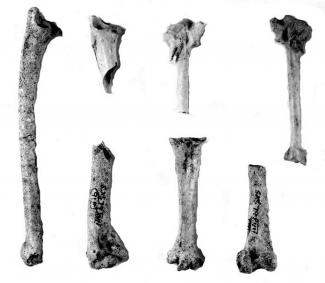The king's hawk
Medieval, mid- 12th-mid- 13th century
Found during excavations by Winchester Museums Service Archaeology Section at Sussex Street, Winchester in 1979
This at first sight unremarkable group of bones is from a gyrfalcon, the largest species of hawk in north western Europe. It was extinct in England by medieval times and this bird probably came from Scandinavia or Iceland. The Boke of St Albans, written by Dame Juliana Berners, prioress of Sopwell nunnery in 1486 records that the gyrfalcon is associated with kings, and appropriately, the property known as the Hawk-Mews (hauckheye), built for Henry II outside the West Gate is close to the 1979 excavation trench.
The Hawk-Mews was maintained for the king throughout the reigns of Henry II, Richard I and John (1154-1216), but seems to have passed out of royal hands by the middle of the 13th century, during the reign of Henry III (1216-1272). Falconry was an expensive sport and was seen in medieval times to reinforce the social order, so that a person's position in society determined what kind of bird they were allowed to own. Political alliances could also be cemented by gifts of hunting birds, and perhaps our bones were once the gift of a Scandinavian king to the king of England.
Photo by John Crook.



